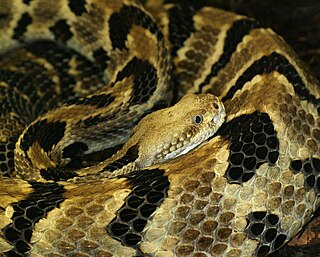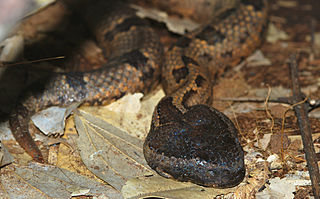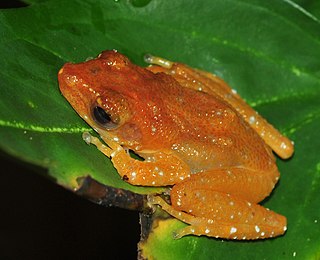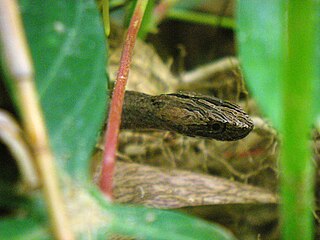
The Crotalinae, commonly known as pit vipers, crotaline snakes, or pit adders, are a subfamily of venomous vipers found in Eurasia and the Americas. They are distinguished by the presence of a heat-sensing pit organ located between the eye and the nostril on both sides of the head. Currently, 22 genera and 151 species are recognized: These are also the only viperids found in the Americas. The groups of snakes represented here include rattlesnakes, lanceheads, and Asian pit vipers. The type genus for this subfamily is Crotalus, of which the type species is the timber rattlesnake, C. horridus.

The Viperidae (vipers) are a family of venomous snakes found in most parts of the world, with the exception of Antarctica, Australia, Hawaii, Madagascar, various other isolated islands, and north of the Arctic Circle. All have relatively long, hinged fangs that permit deep penetration and injection of snake venom. Four subfamilies are currently recognized. They are also known as viperids. The name "viper" is derived from the Latin word vipera, -ae, also meaning viper, possibly from vivus ("living") and parere, referring to the trait viviparity common in vipers but not in snakes at large.

A snakebite is an injury caused by the bite of a snake, especially a venomous snake. A common sign of a bite from a venomous snake is the presence of two puncture wounds from the animal's fangs. Sometimes venom injection from the bite may occur. This may result in redness, swelling, and severe pain at the area, which may take up to an hour to appear. Vomiting, blurred vision, tingling of the limbs, and sweating may result. Most bites are on the hands, arms, or legs. Fear following a bite is common with symptoms of a racing heart and feeling faint. The venom may cause bleeding, kidney failure, a severe allergic reaction, tissue death around the bite, or breathing problems. Bites may result in the loss of a limb or other chronic problems. The outcome depends on the type of snake, the area of the body bitten, the amount of venom injected, and the general health of the person bitten. Problems are often more severe in children than adults, due to their smaller size.

Trimeresurus popeiorum is a species of venomous pit viper in the family Viperidae. The species is native to northern and northeastern parts of India, Southeast Asia, and parts of Indonesia. Common names include: Pope's pit viper, Pope's tree viper, and Pope's bamboo pitviper. Two subspecies are currently recognized, including the nominate subspecies described here.

Psammodynastes pulverulentus, the common mock viper, is a species of snake native to Asia.

Echis is a genus of venomous vipers found in the dry regions of Africa, the Middle East, India, Sri Lanka and Pakistan. They have a characteristic threat display, rubbing sections of their body together to produce a "sizzling" warning sound. The name Echis is the Latin transliteration of the Greek word for "viper" (ἔχις). Their common name is "saw-scaled vipers" and they include some of the species responsible for causing the most snakebite cases and deaths in the world. Twelve species are currently recognized.

Calloselasma is a monotypic genus created for a venomous pit viper species, C. rhodostoma, which is endemic to Southeast Asia from Thailand to northern Malaysia and on the island of Java. No subspecies are currently recognized.

Ovophis is a genus of venomous pitvipers found in Asia. Six species are currently recognized.

Nyctixalus pictus, also known as cinnamon frog, cinnamon treefrog, cinnamon bush frog, painted Indonesian treefrog, and white-spotted treefrog, etc., is a species of frog in the family Rhacophoridae. It is found in the Malay Peninsula, the Philippines, and parts of the Greater Sunda Islands.

Trimeresurus puniceus is a venomous pitviper species endemic to Southeast Asia. Common names include: flat-nosed pitviper, flat-nosed pit viper, and ashy pit viper. No subspecies are currently recognized.

Trimeresurus sumatranus is a venomous pitviper species found in Thailand, Malaysia and Indonesia. Arboreal, its coloration is pale green with a red tail. Common names include Sumatran pitviper, Sumatran tree viper, and Sumatran pit viper.
Trimeresurus malcolmi is a venomous pitviper species found in East Malaysia. Common names include: Malcolm's pitviper, Malcolm's tree viper, and Mt. Kinabalu pit viper.

Trimeresurus borneensis, commonly known as the Bornean pit viper, is a venomous pit viper species endemic to the island of Borneo. No subspecies are currently recognized.

Trimeresurus hageni, commonly known as the Hagen's pit viper, is a species of pit viper, a venomous snake in the subfamily Crotalinae of the family Viperidae. The species is endemic to Southeast Asia. There are no subspecies which are currently recognized as being valid.
Garthius chaseni commonly known as Chasen's mountain pit viper, Chasen's tree viper, and the Kinabalu brown pit viper, is a species of venomous pitviper in the family Viperidae. The species is endemic to the island of Borneo in Malaysia. No subspecies are currently recognized. It is monotypic in the genus Garthius.

Psammodynastes is a genus of snakes of the family Lamprophiidae.














